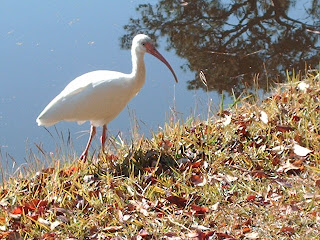I've often said this entire island is a garden, but in
 |
Azaleas in November.
|
November there is a limit to what's actually in bloom. That does not mean that there's not plenty to see. A fairly new addition is the Coastal Discovery Museum at Honey Horn. One of the oldest parcels of land, Honey Horn has passed thru many hands to wind up owned by the City of Hilton Head and operated as a museum with 68 acres of land and some interesting gardens.
The museum focuses on the history of the island, which is really the
history of America's first freedmen. The slaves of these barrier
islands (Hilton Head, St. Helene, Dataw, Lady Island and many smaller
ones) were among the first people freed when Union forces started taking
lands along the Carolina cost after the fall of Ft. Sumter. Originally
formed into several small communities these freedmen and their
descendants lived on this land for nearly 200 years before vacation
development made it popular, and led to a bridge to the mainland. The
museum and its plantings reflect this history.
 |
Bi-color Oleander.
|
 |
Yupon Holly
|
 |
| Indigo - leaves an |
There are small plantings of South Carolina's history crops - Sea Island cotton, indigo, and rice. Sadly, little Sea Island cotton remains - remember the bole weevils from early American history? - and rice production has moved elsewhere, but here you can see these founding plants that aided in the agricultural growth of our country. There are also vegetable plantings to illustrate what was grown for the table and to sell for income in those early years.
In only its fourth year, there is still much to be developed

at Honey Horn and many opportunities for community involvement. An interesting little garden, this was a project for an Eagle Scout who planted this area in native carnivorous plants. There are both red and yellow pitcher plants that are native, as well as Venus Fly Trap. And, I suspect the scout designed and "planted" the planter, too.
 |
| Red Pitcher Plant |
The only "formal" garden is filled with camellias - sadly, not yet in full bloom. The early blooming varieties were lovely and the promise for later in December and January makes me want to come back soon.
One of the wonders of this farm, tho, is the trees. One red cedar is thought to be more than 400 years old. There are several individual trees that are the largest in the state, and there is Spanish Moss everywhere. The feeling of the farm is one of peace and industry, filled with human history. In ten more years, I predict it will be gorgeous.
There is also an interesting sculpture exhibit going on ... but that's a post for another day.
 There's so much to be thankful each year. This year it's the sun coming up over the ocean; the Colonel and Dora who are spending the week with us; the 352nd home a month early; and friends in the blogosphere.
There's so much to be thankful each year. This year it's the sun coming up over the ocean; the Colonel and Dora who are spending the week with us; the 352nd home a month early; and friends in the blogosphere. 








